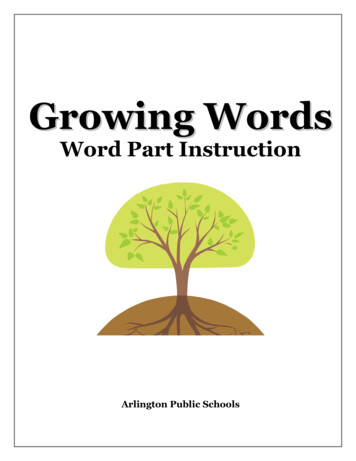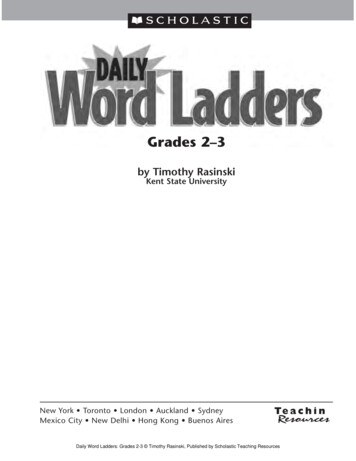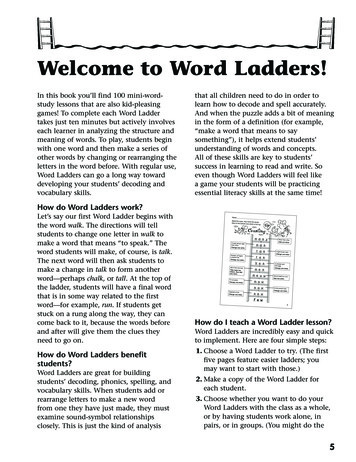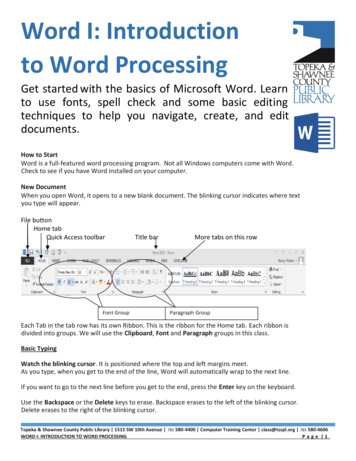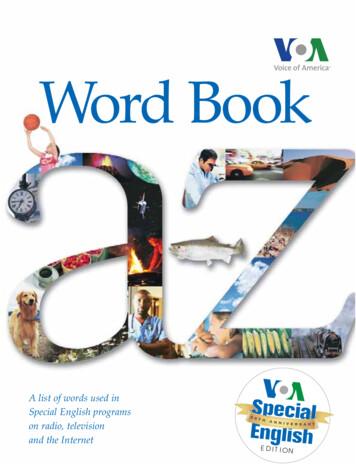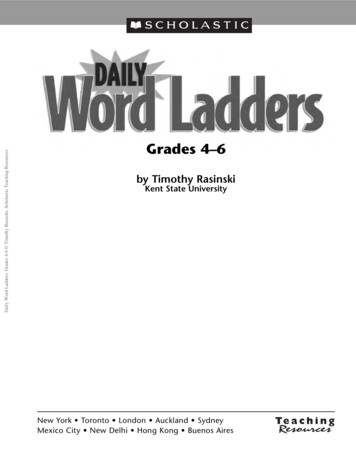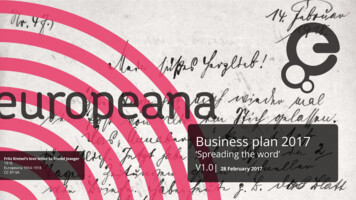
Transcription
Business plan 2017‘Spreading the word’V1.0 28 February 2017
Strategic prioritiesWe are proud to present this year’s business plan, the first one toalign with the strategic priorities that we developed to becomemore efficient, engaging and impactful as Europe’s platform fordigital cultural heritage.#Allezculture!Jan Muller(Chair of the Europeana Foundation GoverningBoard)Jill Cousins(Executive Director of the Europeana Foundation)Merete Sanderhoff(Chair of the Europeana Network Association)BP 2017CC BY-SA
Impact assessmentWe believe it is important to be specificabout our definition of success and toprovide meaningful insights on theprogress we are making. Where theStrategy gives direction, the impactstatements describe the state of changethat we would like to achieve together. Wedescribe this state of change for eachmarket segment and include indicatorsthat give us the best information aboutour performance at this stage.BP 2017CC BY-SA
Market focusWe have chosen to organise our work around five keymarkets that are connected through our platform.This organisational principle will allow us to iterateour services faster to meet audience demands andincrease our overall impact.BP 2017CC BY-SA
Market 1: Cultural Heritage InstitutionsIMPACT STATEMENT“(In 2020) decision makers in Cultural HeritageInstitutions (CHIs) feel rewarded as active participantsin a culturally connected platform for Europe built onthe principles of openness, mutuality and trust. Beingpart of Europeana has both connected them withpeers and helped them make their collectionsavailable, in high quality, with standardised rightsstatements that allow for reuse by the general publicand for use in education, research, and creativeindustries.”BP 2017CC BY-SA
Cultural Heritage InstitutionsMARKET DYNAMICS Cultural Heritage Institutions have adopted a variety of strategies to make their collections available online,and they have access to multiple publication channels to do so besides Europeana. Primarily, CHIs do thisthrough their own websites, but also via commercial platforms like Facebook and Pinterest, or via onlinedigital collections platforms like Google Arts and Culture, Google Books and/or Wikimedia platforms.Europeana already counts a significant number of CHIs among its data partners, both directly or indirectlyvia aggregators.Europeana offers a unique service to CHIs that wish to connect their collections with others in apan-European platform, while keeping control over how open their data should be and therefore whatonward use can be made of it: in research, education, in commercial applications and platforms, and onopen content platforms like Wikimedia Commons.Europeana also offers CHIs and their staff the opportunity to actively engage in the Europeana Network toboth share with and acquire expertise from their peers and to become part of the governance ofEuropeana itself.BP 2017CC BY-SA
Cultural Heritage InstitutionsMAKING IT EASIERImprove the aggregation model Europeana will make the pathways to publishing with Europeana simpler,more streamlined and better documented on Europeana Pro. A new approach to Aggregation in Europe will becreated by all types of aggregators in the first six months of 2017.Greater individual and domain specific support Working with the domain aggregators and expert hubs we willencourage institutions along the entire aggregation chain to increase the amount of data in Europeana that is ofhigh quality and available for reuse. For institutions with high-quality digital collections that match the prioritised themes or institutions thatwish to upgrade their existing content, we will provide support by means of our helpdesk service, trainingworkshops, data & infrastructure evaluation, and by normalising & improving domain specific information.The Europeana Aggregator Network will share knowledge, best practices, success stories, and guidance forinstitutions on technical and legal requirements.We will maintain, develop and foster domain standards, vocabularies and resources, and offer institutionssupport for the work with specific tools, like MINT and MORe.BP 2017CC BY-SA
Cultural Heritage InstitutionsMAKING IT EASIERPublish and implement the new content strategy With an emphasis on quality over quantity, we will liaiseclosely with expert hubs and aggregators to proactively identify new collections and partners for publication inEuropeana. Selection will be based on user demand, quality and richness of content (Europeana PublishingFramework tier compliance) and theme alignment.Update the Europeana Publishing Framework Clarifying the technical requirements for video, audio and texts.In late 2017, we also aim to introduce a metadata quality component to the framework as the tiers are currentlybased solely on the presence and licensing of media.BP 2017CC BY-SA
Cultural Heritage InstitutionsMAKING IT EASIERImprove the aggregation tools Europeana will introduce a new aggregation service, Metis, for greaterautomation of data publication flows, improved data quality reporting and incremental harvesting and publication.The new service will connect with existing aggregation and data processing tools in use by national aggregatorsand other partners.Aggregation research and development Prototyping and testing new technologies to make publishing digitalcollections with Europeana even easier, with retained demands on high quality that will continue this year. This is along-term commitment to research and development, and not every prototype solution will make it intoproduction.Publishing curated content Europeana exhibitions CMS will be made available to more CHIs to allow them tocurate and publish exhibitions that feature their own content as well as that of other partners. Exhibitions thatmatch with existing and planned thematic collections will be prioritised. Exhibitions published in our previousexhibitions CMS will be re-published in the new style that was introduced with Faces of Europe.BP 2017CC BY-SA
Cultural Heritage InstitutionsMAKING IT MORE REWARDINGImproved statistics reporting Improvements will include showing the reach of content on key external siteslike Wikipedia, Facebook, and Pinterest on platform level. We will also add more key metrics to the existingreports, for example media views and downloads, and also include statistics reports for exhibitions and blogposts. The simple content reports will be complemented with Tier metrics and generalised metadata qualitymetrics. Detailed metadata quality metrics will be provided in Metis.More Impact assessment and case studies Based on the Europeana Impact Assessment Framework we willpublish an ambitious impact case study on the innovation value of Europeana for CHIs. The Impact AssessmentFramework itself will also be documented in such a way that CHIs can adopt it for their own use and purposes. Inaddition to that, we will also publish a series of smaller impact case studies about the value of publishing withEuropeana.BP 2017CC BY-SA
Cultural Heritage InstitutionsMAKING IT MORE REWARDINGAggregator quality improvement plans Aggregators funded by the Europeana DSI will devise and implementcontent quality improvement plans aligned with BP 2017 goals (improve existing data, support limited andtargeted new data acquisition). The goals of each aggregator will vary but should include aspects like link fixing,adding descriptions and meaningful titles, increase the use of controlled standards compliant vocabularies, andincrease the average Europeana Publishing Framework tier level of their aggregation.Detailed data quality reports With the launch of Metis we will introduce detailed data quality reports. Eachpartner will be able to access reports that provide fine grained metrics from individual object fields to datasets asa whole. The dimensions and formulas will be based on the work of the data quality working group.Data Quality Working GroupData quality improvement is ongoing work and one that requires thecontributions of the Europeana Data Partners and Aggregators as a whole. Therefore, the Data quality workinggroup that was initiated in 2016 will continue its work to identify issues with data quality and suggest solutions.BP 2017CC BY-SA
Performance indicatorsKEY PERFORMANCE INDICATORS 2017 Establish the components of a Net Promoterscore baseline60% of participating CHIs rate Europeanaservices 4 or higher on a Likert scale of 1-5Increase the percentage of Tiers 3 and 4material to at least 16% of the totalBP 2017CC BY-SA
Market 2: European citizensIMPACT STATEMENTA) General Public “(By 2020) the general public haseasy access to trustworthy digital cultural heritage intheir workflow, and they are inspired to activelycontribute, reflect on and share in creating apan-European cultural identity”.B) Culture Lovers “(By 2020) culture lovers andlife-long learners appreciate Europeana products &services as aligning with their values and providingthem with meaningful and inspiring onlineexperiences that allows them to learn more aboutEuropean cultural heritage and to create new thingswith it”.BP 2017CC BY-SA
European citizensMARKET DYNAMICSThe ‘market’ of European Citizens is notoriously hard to define. Some people are heavy users of online culture, someless. The same individuals can be a professional use case when they’re looking for visual materials for the class theyare teaching on the Renaissance and casual users when they’re looking for pictures of their grandmother's homevillage or checking out an exhibition unrelated to their work.OUR STRATEGYBecause we believe that cultural heritage belongs to us all, we aim to make the material we have gathered availablein as many places as possible. Hence, to maximise our impact, we are taking a three-pronged approach: Reaching the more general public in two ways: we bring their cultural heritage to places where they arealready present, such as Wikipedia, Pinterest and other social media.Developing large, pan-European themed campaigns where we invite them not only to consume but toparticipate.We design the Europeana services, including Europeana Collections, thematic collections and exhibitionsprimarily for the ‘culture lovers’ - people with a deeper than average interest in culture.BP 2017CC BY-SA
Culture loversMAJOR DEVELOPMENTSEuropeana Collections The improvements to Europeana Collections will focus on search and retrieval, SearchEngine Optimisation by building entity collections, and experiment with the addition of a couple of interactivefeatures such as the ability to annotate. Furthermore, with the integration in the stack Europeana 1914-1918, auser-generated content (UGC) component will also become available to other collections and thematic campaigns.Thematic collections We want culture lovers to engage with their cultural heritage. User surveys have shownthat the engagement levels of thematic collections are three times higher than average: users stay longer, bounceless and visit more pages. Curating higher quality data (Tier 2 and higher) and targeting specific audiences pays off.Thus, in addition to the already existing Art and Music collections the Europeana Fashion Association will launchEuropeana Fashion, the Europeana Photography Consortium will run Europeana Photography and EuropeanaNewspapers will be developed by partners under supervision of the Staatsbibliothek zu Berlin.BP 2017CC BY-SA
General publicMAJOR DEVELOPMENTSThird party platforms To maximise our reach to the general public, we will continue our successful cooperationwith the Wiki community. Working closely with the local chapters we will support Cultural Heritage Institutionswith Tier 4 material to upload to Wikimedia Commons and to participate in the GLAM-wiki challenge that runs onthe theme of 1914-1918. Similarly, we will continue to develop partnerships with strong thematic brands likeDailyArt to support seasonal campaigns such as on Art Nouveau.Social Media We’ll continue sharing cultural heritage material with European citizens on relevant social channels,making our messages interesting and engaging in order to be heard in a competitive and ‘noisy’ environment. Wewill employ proven methods of interaction with people: putting content in context, using popular hashtags,participating in online events (#GIFitUP and #ColorOurCollections). We will closely follow industry developmentsand adapt our activities to changing algorithms and relevant trends. Providing access to even more openlylicensed content will be central to our approach, matching the available material with a suitable social mediaplatform, such as SoundCloud for Music, Instagram & Tumblr for Fashion, Pinterest for Art & Photography, Redditfor Europeana 1914-1918, and Medium for blogs.BP 2017CC BY-SA
General publicSPOKEN & WRITTEN WORD CAMPAIGNIn February, together with our library and archivepartners, we kicked off a social media and onlinecampaign called #AllezLiterature to engage people andhighlight the importance and significance of the spokenand written word. The libraries and archives help byhighlighting and potentially improving or deliveringmaterial against the theme. We will strengthen thecampaign by linking to existing text-related programmessuch as Europeana 1914-1918 transcribathons, and tointernational ‘word’ related milestones including WorldPoetry day & World Book day.Campaign platforms will focus on existing channels, primarily social media and a relaunch of the Reading Europeexhibition. The campaign will be developed and executed by Europeana and Libraries and Archives with supportfrom the Europeana Network Association’s #AllezCulture group.BP 2017CC BY-SA
General publicBUILDING UP TO 2018Campaigns need considerable lead time when they aim to cover 28to 32 countries. The year 2018 will see the European Year ofCultural Heritage (EYCH) and the centenary of the First World Warin which we will both fully participate. Two major campaigns areenvisaged for 2018 that will be constructed during 2017. They willbe localised and managed by Member States and Cultural HeritageInstitutions.Migration and Culture For Migration and Culture we will engage Member States, CHIs and the public to sharestories about migration in Europe over the centuries and its influence on European culture and identity. We willlink the campaign to the EYCH.Europeana 1914-1918 We will also run a Europeana 1914-1918 campaign - with a centenary tour of collectiondays and transcribathons - to commemorate the centenary of the end of the First World War and the birth ofEurope. We will link this campaign explicitly to flagship projects that the Commission has planned under EYCH,working with partners such as Europa Nostra and UNESCO.BP 2017CC BY-SA
Performance indicatorsKEY PERFORMANCE INDICATORS 2017 Establish the components of a Net Promoterscore baseline for thematic collections 60% 4 average user satisfaction for all thematiccollections, exhibitions and blog (culture lovers)Reach of Europeana data: Total impressions 3rd parties: 125 million Total impressions social media: 75 million Total engagement social media: 318 thousand Traffic overall: 6 million visitsEngagement on Europeana products Returning visitors 30% average on allthematic collections Downloads: 180 thousand Click-throughs: 1.2 millionBP 2017CC BY-SA
Market 3: researchIMPACT STATEMENT“(By 2020) Digital Humanities Researchers useEuropeana as a trusted source of cultural heritagedata to develop new knowledge and insights from ourpast or create new research methodologies. They canuse the data directly from the Europeana platform orthey can find it in research-related web services andnetworks. By nurturing partnerships that place thedata in the workflow of the researcher, and allow fordownload of high-quality re-usable cultural heritagedata we reduce their transaction costs for finding andmining primary resource materials for their research.”BP 2017CC BY-SA
ResearchMARKET DYNAMICS Academic research in the Digital Humanities is a diverse and emerging market with high impact potential forsociety. *Read Melissa Terras’ impact paper.Access to digital cultural heritage resources is key for this market, but is hampered by lack of digitisation,particularly of 20th century material and by copyright issues.Researchers are the largest and most satisfied user base of Europeana Collections.Data that is of poor quality to most people can be of use to the digital humanities and linguistics researcherwanting to show patterns or visualisations.Access to resources is provided primarily through Research Infrastructures (for example CLARIN).There is a growing movement within libraries to deepen their relationship with national research networks,for example through the development of Lab environments (i.e. Royal Library in the Netherlands, BritishLibrary).Europeana for Research Recommendations give more insights into the use of cultural heritage in research.BP 2017CC BY-SA
ResearchMAJOR DEVELOPMENTSImproving policy Promotion and follow-up of Europeana for Research Recommendations.We will develop a case study of our current and potential impact in this market.Scaling with partners Research Infrastructure and systems partnerships are key to the development of this market. The form ofthese partnerships will vary from API delivery to data dumps or Linked Open Data access.The two existing partnerships will be nurtured, and two additional partnerships that make use of the data atscale will be investigated during 2017.Work with our Europeana Research Advisory Board to provide the tools and services and data needed bydigital humanities and linguistics researchers.Establish a network of European Research Labs to better exchange best practices across Europe.BP 2017CC BY-SA
ResearchREACHING THE MARKET Researchers will be encouraged to directly interact with Europeana data via Europeana Collections andEuropeana Research as our shop window for Researchers to access Europeana data via the APIs, curateddata sets, data dumps, the full text newspaper collection, and the TEL linked open data set of Europe’slibrary bibliographic data.Researchers will also be encouraged to use Europeana Collections and to publish any open sets they createon Europeana Research for others to use.Encouragement will also take the form of an annual Grants programme for Researchers.RECORDING THE RESULTS We will create case studies for the three winners of the 2016 programme, and we will find ways of encouraging the submitters for the 2016 grants programme to stay close.Feedback loops on what researchers want in terms of data as well as tools and services will be introduced.BP 2017CC BY-SA
Performance indicatorsKEY PERFORMANCE INDICATORS 2017 Establish the components of a Net Promoterscore baseline60% of users rate Europeana services 4 orhigher on a Likert scale of 1-5Consolidate partnerships with the two (2)research infrastructures that make Europeanadata availableThree publishable case studies from grantfundingBP 2017BP2017CC BY-SACC BY-SA
Market 4: educationIMPACT STATEMENT"(By 2020) teachers in secondary education use moredigital cultural heritage resources in their classrooms.By making it easy to find and download high-qualitycultural heritage data via Europeana we have reducedthe transaction costs for publishers of educational andlearning services, helping teachers to deepen theirstudents’ understanding of our shared heritage andshape innovative and inspiring future classrooms.”BP 2017CC BY-SA
EducationMARKET DYNAMICS Education is a vast and pluriform market: online and offline education, formal and informal education.Formal education (5-18 years) is highly regulated by national governments.The market includes various and numerous stakeholders: public and private players, national Ministries ofEducation, schools, universities, teachers, educational publishers, and new stakeholders such as onlineeducational providers. They cater to very large numbers of users - they can be pupils, students (formaleducation) to practically everyone for lifelong learning.There is a trend towards more collaborative learning using (visual) digital resources that can be usedinside and outside of classrooms. *See Europeana4Education recommendationsThe market stands at the beginning of the digital shift, and is therefore in need of digital resources makingthe timing for working in this space appropriate.BP 2017CC BY-SA
EducationIn 2017, Europeana will focus on investigating how to partner in secondary education in six countries: theNetherlands, France, Portugal, Italy, Spain, and Finland. Secondary markets are primary formal education andlifelong learning (OER and commercial). We will address the following audiences:Policymakers DG Education and Culture, National Ministries of Education. They will help promote Europeana asan educational resource on European and national level and facilitate access to key national educationalpublishers.Non-commercial partners Educational NGOs and associations (European Schoolnet, EUROCLIO). They willintegrate Europeana Collections in their online portals and help us reach educators across Europe.Commercial partnersEducational publishers, learning software providers and content developers. They willfeature (curated selections of) Europeana Collections on their platforms (Maskott), create and publish learningresources with Europeana content (MOOCs, e-books, Apple’s iTunes U course) and/or develop educationalapplications and games (ArtFACES).BP 2017CC BY-SA
EducationMAJOR DEVELOPMENTS Access to sets of suitable curated resources is key in this market. We will deliver this through API queries (fordevelopers). We will also feature teacher and partner curated datasets on the newly redesigned EuropeanaPro site.We will support the development of educational resources through match, challenge and investor funding.For example, we will matchfund up to three educational projects through our partnership with Goteo ororganise a challenge for education software developers or bring high-potential educational projects to theinvestor forum in June 2017.We will support community initiatives that use Europeana as a key resource. For example, we will work ondeveloping the Europeana4Education community and on establishing a network of teacher ambassadors inEurope.Full 2017 plans for Europeana in the Education market will be made available in the ‘Europeana forEducation Business Plan’.BP 2017CC BY-SA
Performance indicatorsKEY PERFORMANCE INDICATORS 2017 Establish the components of a Net Promoterscore baseline60% of users rate Europeana services 4 orhigher on a Likert scale of 1-5Develop three new educational partnershipsthat make Europeana data availableBP 2017CC BY-SA
Market 5: creative industriesIMPACT STATEMENT“(By 2020) Creatives (developers, designers, makersand entrepreneurs) develop new products andservices inspired by the content and creativeexamples we make available to them. We havereduced their transaction costs for developingproducts, services and creations by making it easy tofind and use high-quality re-usable cultural heritageassets and by improving access to funding. Some ofthese are developing into marketable productssupporting European economic growth. Some ofthem increase awareness of our past throughentertainment and creative expression.”BP 2017CC BY-SA
Creative industriesMARKET DYNAMICS Creative industries (CIs) are a broad and increasingly fragmented market.Dominated by micro- and small enterprises, 95% of the CI businesses are small businesses with up to nineemployees.No dominant players.The creative industries generate an annual revenue of 535.9 billion EUR.Employs more than 7 million workers (primarily in very small business) within the European Union, andaccount for 11.2% of all private enterprises.Continuously growing market, with social entrepreneurship and sharing economy as strong growthdrivers.Challenges and monetary incentives are increasingly seen to be inducement mechanisms.BP 2017CC BY-SA
Creative industriesMARKET SEGMENTATIONThe breadth of the creative industries market requires that we focus on a primary target submarket. For 2017, wewill work on creatives working as Digital entrepreneurs and investigate Makers as a potential target submarket.Primary market - Digital entrepreneurs Designers, art and fashion students, creative directors, developers.They share an interest in using digital cultural content in their (sustainable) projects.(Potential) Secondary Market - Makers High-level amateur and professionals who can demonstrate originalityand excellence in using digital and technological means (e.g. computer-aided design, 3D printing or laser cutters)in concept, design and process to produce digital or physical products.BP 2017CC BY-SA
Creative industriesMAJOR DEVELOPMENTS Support the development of viable business ideas through direct funding (Europeana challenges), matchfunding (matching crowd donations in crowdfunding campaigns on our partner platform Goteo) and accessto investment (investor fora).Make sure Europeana Labs works as a window to everything Europeana can offer to digital entrepreneurs,including the showcasing of their products.Develop further the network of multipliers, such as innovation labs, cultural heritage labs, and hackathonnetworks, to reach the target creative audiences through their professional affiliations.Investigate the makers market.Full 2017 plans for Europeana in the creative industries market will be made available in the ‘Europeana forCreative Industries Business Plan’.BP 2017CC BY-SA
Performance indicatorsKEY PERFORMANCE INDICATORS 2017 Establish the components of a Net Promoterscore baseline60% of users rate Europeana services 4 orhigher on a Likert scale of 1-5Minimum of 20 new products and servicesinspired by or developed with EuropeanacontentBP 2017CC BY-SA
Europeana Network AssociationEuropeana GovernanceIMPACT STATEMENT“(In 2020) more Association members feelconnected to each other through the principles ofopenness, mutuality and trust. The EuropeanaNetwork Association and its dedicated communitieshave enabled each member to advance his/herknowledge and work practices. Together they havecreated the conditions for cultural heritage tobecome more accessible to citizens, school kids,digital humanists and creatives and thuscontributed to Europeana’s impact.”BP 2017CC BY-SA
Europeana Network AssociationThe Europeana Network Association is a democratic and transparent governed body that represents the interests ofindividuals who work with or contribute to Europeana and support the Europeana Commons principles. Activitiesforeseen for 2017 cover a range of areas:Members Council We have just elected a new Council and Management Board who will meet two to three times in2017 as representatives of the Europeana Network. They will ensure communication flows between the EuropeanaFoundation and Network, they will actively support the #AllezCulture and Copyright Reform campaigns and supervisethe activity of six to seven Working Groups and eight to ten Task Forces that are set up to operate as instruments forthe Network Association.Europeana Network Association General Assembly The annual General Assembly (GA) will take place this year inDecember, alongside the bi-annual European Cultural Forum. The GA is the legal convention where all Networkmembers are invited to discuss association matters and where voting can take place. The GA marks the launch of theannual Members Council (MC) elections and the Association official papers’ endorsement, such as a budget andactivity plan. In 2018, the MC will further grow to 43 councillors in total.BP 2017CC BY-SA
Europeana Network AssociationPreparing the Europeana Conference in 2018 In the first half of 2018, we will also hold a large plenary conferenceas part of the European Year of Cultural Heritage. This will be a great opportunity to discuss and showcase the widevariety of things happening in and around our industry with tracks on Tech, Copyright and Creativity.Europeana Presidency eventsWe organise two ‘EU Presidency events’ each year, with the aim to involvepolicymakers across Member States in the use of cultural heritage in our five markets. The Maltese Presidency event(May) and the event in Estonia (Q3/Q4) will help us deepen and broaden our relationships with policymakers inculture, education, and research. We will raise awareness and develop concrete recommendations for actions thatcan be taken to amplify the role of cultural heritage in society. The theme for the Maltese event will be ‘Migrationand Culture: how can our past educate our present’?BP 2017CC BY-SA
Performance indicatorsKEY PERFORMANCE INDICATORS 2017 Establish the components of a Net Promoterscore baselineMinimum of 1,800 Network AssociationmembersSix active Task ForcesFive active Working GroupsBP 2017CC BY-SA
Policy and framework developmentRightsstatements.org governance and networkRightstatements.org has become an important component of our aim to develop truly international frameworks forinteroperability of cultural heritage data. This year we will focus on developing a lightweight governance structure withDPLA and other international digital platforms. Europeana Foundation will host the coordinator of activities, which willinclude broadening the network, find funding, develop new rights statements, and maintenance of the website.Impact assessment frameworkThe Europeana Impact Assessment Framework was met with a lot of enthusiasm in our Network and will be furtherimplemented this year. Our first aim is to create an environment where we can share inspiration and best practices(Q2). With the support of a task force we will then further develop this into a ‘toolkit’ that can be used to design, assessand narrate impact of cultural
Business plan 2017 'Spreading the word' . more streamlined and better documented on Europeana Pro. A new approach to Aggregation in Europe will be created by all types of aggregators in the first six months of 2017. Greater individual and domain specific support Working with the domain aggregators and expert hubs we will



